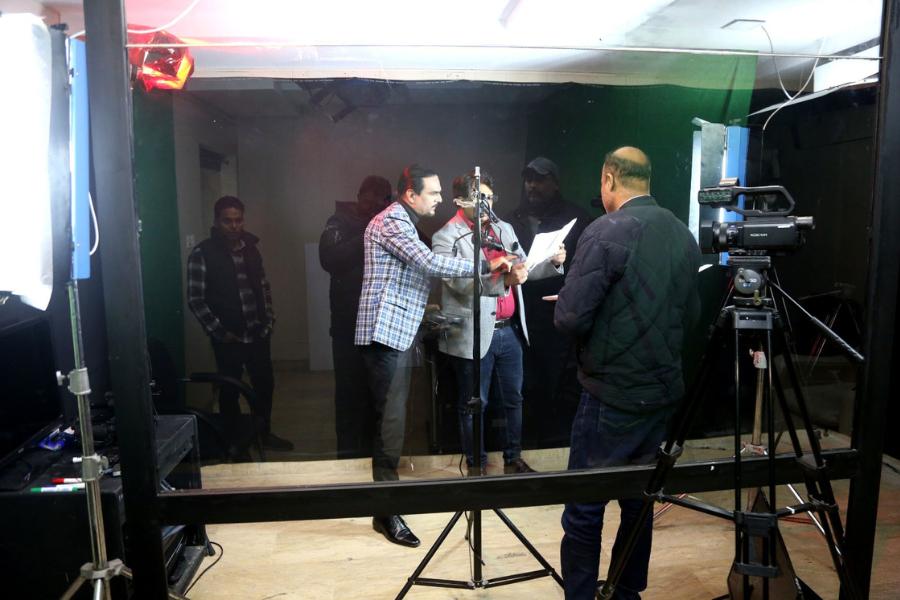Table of Contents
Introduction to Art Direction
Step into the enchanting world of art direction, where mesmerizing colors, typography, and captivating visual narratives breathe life into modern media. Let’s embark on a journey through this creative labyrinth, where each stroke and pixel weaves the spellbinding magic of storytelling. Art direction is not just about aesthetics; it is a cornerstone in crafting the visual identity and narrative essence within today’s media. This dynamic discipline encompasses a myriad of creative choices that shape how audiences perceive and interact with content across diverse platforms. Evolving alongside technology and audience preferences, art-direction continues to be a driving force in the ever-changing realm of media storytelling.
Key Elements of Art Direction

In modern media, art-direction revolves around carefully chosen color palettes, thematic consistency, typography and fonts that complement the overall design, and a distinct visual style that sets a project apart. These elements work together to create cohesive and compelling visuals that resonate with the target audience.
1. Color Palette:
Colors evoke emotions and set the mood.
Example: A children’s website might use a bright and cheerful color palette with primary colors, while a luxury brand website might use a more sophisticated palette with black, gold, and white.
2. Thematic Consistency:
Everything should visually connect to the overall theme.
Example: A movie set in space will have a distinct color palette, props, and costumes that all contribute to the feeling of being in a futuristic world.
3. Typography and Fonts:
Fonts can be playful, serious, or elegant, depending on the message.
Example: A heavy metal band’s logo might use a bold, spiky font, while a law firm’s website might use a classic serif font that conveys trust and authority.
4. Distinct Visual Style:
This creates a unique look that sets the project apart.
Example: The stop-motion animation style of Wes Anderson’s films is instantly recognizable, creating a quirky and whimsical atmosphere.
Art Direction in Different Media
Art direction manifests differently across different media forms such as print, digital platforms, film, television, and advertising. Each medium requires unique considerations in terms of design principles, technical aspects, and audience engagement strategies.
1. Print Media:
Considerations: Layout, typography, color palettes that work well when reproduced physically.
Example: A magazine spread showcasing a new fashion line. The art director would choose models, clothing arrangements, background colors, and fonts to create a specific mood and highlight the clothing.
2. Digital Platforms:
Considerations: User interface (UI) design, responsiveness across devices, how users interact with the visuals.
Example: A company website. The art director would determine the overall visual style, including color schemes, imagery, and button placement, to ensure a user-friendly and visually appealing experience.
3. Film:
Considerations: Lighting, set design, costume design, camera angles, how these elements work together to tell the story.
Example: A science fiction movie. The art director would collaborate with the director to create a futuristic world through set design, props, and costume choices that reflect the film’s narrative.
4. Television:
Considerations: Similar to film, but with additional factors like commercial breaks and shorter attention spans.
Example: A sitcom. The art director would design the sets (living room, kitchen) to reflect the characters’ personalities and create a sense of familiarity for viewers.
5. Advertising:
Considerations: Capturing attention quickly, conveying a clear message, and aligning with the brand’s identity.
Example: A billboard advertisement. The art director would choose a powerful image, concise text, and a color scheme that grabs attention while effectively promoting the product.
Role of Technology in Art Direction
Advancements in technology have revolutionized art direction, offering designers and directors a wide array of digital tools and software for creating immersive and interactive experiences. Virtual and augmented reality technologies have also expanded the possibilities of art-direction, allowing for more dynamic and engaging content.
Digital Tools and Software:
Graphic Design Software: Programs like Adobe Photoshop and Illustrator have become industry standards. They allow for precise image manipulation, illustration, and layout creation, giving art directors much finer control over the visual elements of a project.
3D Modeling and Animation Software: Tools like Maya and Cinema 4D enable the creation of realistic 3D models and animations. This opens doors for art directors to develop visually stunning concepts and storyboards for films, advertisements, and video games.
Challenges and Trends in Modern Art Direction

While modern art direction offers exciting opportunities, it also comes with challenges such as balancing creativity with practical constraints, addressing sustainability concerns, and staying updated with emerging trends in visual storytelling. Successful art directors navigate these challenges while maintaining high standards of creativity and innovation.
Career Paths and Skills for Aspiring Art Directors
Aspiring art directors can pursue diverse educational backgrounds ranging from design schools to fine arts programs. Essential skills for success include a keen eye for detail, proficiency in design software, strong communication and collaboration abilities, and a deep understanding of visual aesthetics. Career paths may lead to roles in advertising agencies, design studios, film production houses, and digital media companies.
Conclusion
Art direction in modern media is a multifaceted discipline that combines creativity, technology, and strategic thinking. By mastering key elements, embracing technological advancements, navigating challenges, and staying abreast of industry trends, art directors can create impactful visual experiences that resonate with audiences across diverse media platforms.
How to Define Your Own Art Direction Read More.
Unique FAQs
1. What role does color psychology play in art direction?
Color psychology helps art directors evoke specific emotions or convey brand messages through color choices in visuals.
2. How can art-direction contribute to brand identity?
Consistent visual elements and styles developed through art direction help reinforce brand identity and recognition.
3. Is art-direction limited to specific industries?
No, art-direction is applicable across industries ranging from entertainment and advertising to education and healthcare.
4. What software tools are commonly used in art direction?
Adobe Creative Suite, Cinema 4D, and Autodesk Maya are some popular software tools used by art directors.
5. How does art-direction impact user experience in digital media?
Thoughtful art-direction enhances user engagement, readability, and overall aesthetic appeal in digital platforms, improving user experience.

